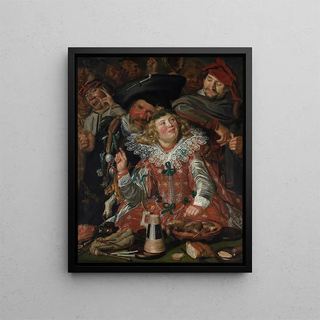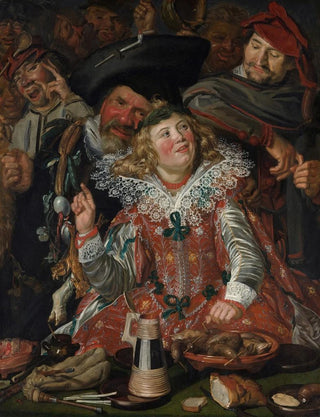Painting Les fêtards du Jour gras - Frans Hals | Art print


View from behind

Frame (optional)
In the vibrant universe of art, certain works manage to capture the very essence of human life, and "Les fêtards du Jour gras" by Frans Hals is a perfect example. This lively canvas, painted in the 17th century, immerses us in a scene of revelry, where conviviality and joie de vivre blend with disarming naturalness. By contemplating this piece, the viewer is transported to a suspended moment, a celebration of the present that still resonates through the centuries. The richness of details and the vividness of colors make this work a true invitation to explore the subtleties of human nature, while offering a fascinating glimpse into Dutch society of the time.
Style and uniqueness of the work
Frans Hals's work stands out for its unique style, characterized by a fluid and expressive painting technique. Unlike his contemporaries, Hals does not dwell on minute details but favors a freer, more dynamic approach. The faces of the revelers, animated by lively expressions, seem almost tangible, while the light plays on the textures of clothing and glasses, creating a warm and lively atmosphere. The colors, bright and contrasting, reinforce the impression of movement and energy emanating from the canvas. Each character, with their gestures and gaze, tells a story, and together, they form a tableau of human conviviality, illustrating the joy of festivities and the importance of social bonds.
The artist and his influence
Frans Hals, an emblematic figure of the Dutch Golden Age, knew how to mark his era with his technical mastery and innovative approach to portraiture. Born in 1582 in Antwerp, he spent most of his life in Haarlem, where he developed a style that is uniquely his own, blending realism and expressiveness. His works, often centered on scenes of daily life, reveal a deep understanding of human nature. Hals influenced many artists, both of his time and subsequent generations, advocating a more free and less conventional approach to painting. His legacy is palpable in the work of painters such as Édouard Manet

Matte finish

View from behind

Frame (optional)
In the vibrant universe of art, certain works manage to capture the very essence of human life, and "Les fêtards du Jour gras" by Frans Hals is a perfect example. This lively canvas, painted in the 17th century, immerses us in a scene of revelry, where conviviality and joie de vivre blend with disarming naturalness. By contemplating this piece, the viewer is transported to a suspended moment, a celebration of the present that still resonates through the centuries. The richness of details and the vividness of colors make this work a true invitation to explore the subtleties of human nature, while offering a fascinating glimpse into Dutch society of the time.
Style and uniqueness of the work
Frans Hals's work stands out for its unique style, characterized by a fluid and expressive painting technique. Unlike his contemporaries, Hals does not dwell on minute details but favors a freer, more dynamic approach. The faces of the revelers, animated by lively expressions, seem almost tangible, while the light plays on the textures of clothing and glasses, creating a warm and lively atmosphere. The colors, bright and contrasting, reinforce the impression of movement and energy emanating from the canvas. Each character, with their gestures and gaze, tells a story, and together, they form a tableau of human conviviality, illustrating the joy of festivities and the importance of social bonds.
The artist and his influence
Frans Hals, an emblematic figure of the Dutch Golden Age, knew how to mark his era with his technical mastery and innovative approach to portraiture. Born in 1582 in Antwerp, he spent most of his life in Haarlem, where he developed a style that is uniquely his own, blending realism and expressiveness. His works, often centered on scenes of daily life, reveal a deep understanding of human nature. Hals influenced many artists, both of his time and subsequent generations, advocating a more free and less conventional approach to painting. His legacy is palpable in the work of painters such as Édouard Manet
12,34 €






